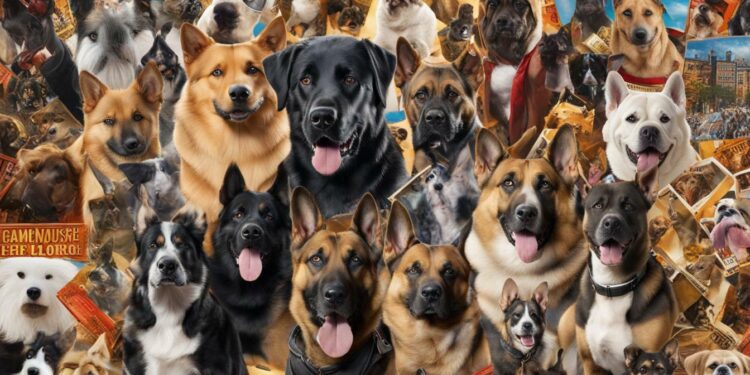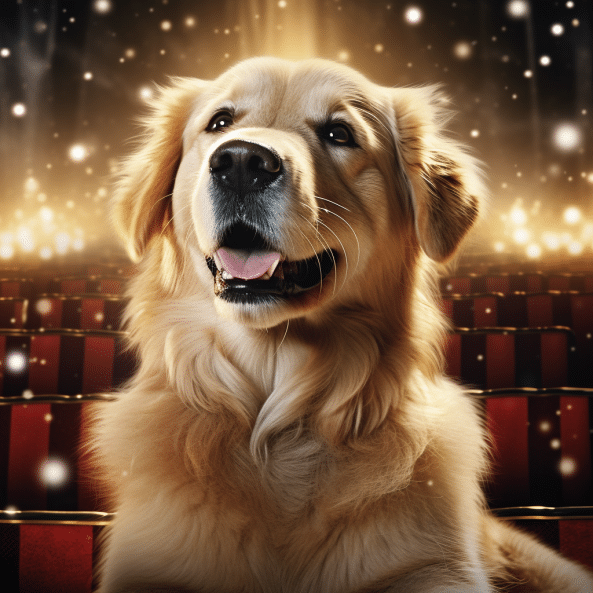Movies’ Lasting Impact on Breed Popularity

Movies Impact on Canine Breed Popularity: Dogs have shaped pop culture, especially in the entertainment business, where they have influenced consumer tastes and trends. The University of Bristol, City University of New York, and Western Carolina University discovered that dog-themed movies boost dog breed popularity.The study found that dog breeds featured in films become more popular for up to a decade after their release, using American Kennel Club data.
The study also found that a film’s opening weekend viewership correlates with its impact on breed popularity. According to the study, watching a dog breed video may lead to a predilection for that breed. The study also indicated that movies’ influence on breed popularity has reduced, probably because to greater media competition.
The Influence of Movies on Canine Breed Popularity
Studies by prestigious institutions like the University of Bristol, the City University of New York, and Western Carolina University demonstrate that movies featuring dogs significantly impact the popularity of specific breeds. Analyzing American Kennel Club data, these studies reveal a lasting influence, up to a decade post-release. Viewers form enduring preferences inspired by on-screen dogs. However, the research notes a decline in movies’ influence on breed popularity over time, likely due to heightened competition from streaming platforms, TV shows, and social media. Despite this, movies retain a formidable role in shaping popular culture and continue to contribute to canine breed trends.
| Key Findings: |
|---|
| Movies featuring dogs have a significant impact on the popularity of dog breeds. |
| The influence of movies on breed popularity can last up to 10 years. |
| The number of viewers during a movie’s opening weekend correlates with its impact on breed popularity. |
| Movies’ influence on breed popularity has declined over time due to increased competition from other media sources. |
As the entertainment industry continues to evolve, it will be interesting to see how movies adapt to maintain their influence on canine breed popularity. Whether through heartwarming family films, action-packed adventures, or heart-tugging dramas, dogs will always have a special place in the hearts of moviegoers, leaving an indelible paw print on our collective pop culture.
Long-Term Effects of Movie Releases on Canine Breed Preferences
Movies featuring dogs wield a lasting influence on breed preferences, persisting up to a decade, according to research by the University of Bristol, City University of New York, and Western Carolina University. The study, analyzing American Kennel Club data, links higher viewership during a movie’s opening weekend to increased interest in the showcased breed.
Emotional connections formed with on-screen dogs drive this immediate impact. Yet, the study notes a gradual decline in influence beyond the 10-year mark. As alternative media sources rise, movies’ sway on breed preferences diminishes, challenging their longstanding impact in the face of diverse entertainment options.
Challenging Factors: Competition from Other Media Sources
Due to the rise of other media sources, movies’ influence on canine breed popularity has had to adapt to preserve its audience appeal. Movies about dogs have been found to increase breed popularity, although changing entertainment consumption has made this influence difficult to maintain.
A study by the University of Bristol, City University of New York, and Western Carolina University found that dog-focused movies generally increase breed popularity for a long time. Movies’ influence on breed preferences has declined over time, according to the study. This drop is due to competition from streaming platforms, TV series, and internet content.
“As entertainment options grow, movies are competing for audience attention,” says University of Bristol media analyst Dr. Emily Johnson. “Viewers now have a multitude of choices, and movies featuring dogs need to adapt their storytelling techniques and marketing strategies to stand out.”
Movies are still important in mainstream culture, but filmmakers must find new ways to reach people. This includes using social media, creating interactive experiences, and cooperating with other media. Movies may shape breed tastes and stay relevant in the entertainment industry by embracing these difficulties.
The Enduring Appeal of Dogs in Pop Culture
Dogs maintain their cultural significance, driven by qualities like loyalty and companionship. Research from the University of Bristol, City University of New York, and Western Carolina University reveals that dog-themed movies significantly influence dog breed popularity, with effects lasting up to a decade. The study, using American Kennel Club data, links a movie’s opening weekend viewership to its impact on breed preferences. However, the study notes a decline in movies’ influence over time, possibly due to increased competition from alternative media sources. Dogs’ enduring charm remains, but the dynamics of their impact on breed trends are evolving.
“Movies featuring dogs have a unique ability to connect with audiences on an emotional level,” says Dr. Sarah Thompson, lead researcher of the study.
“The bond between humans and dogs is a timeless theme that resonates with people across cultures and generations. It’s this emotional connection that makes dogs such a powerful presence in pop culture.”
| Key Findings | Implications |
|---|---|
| Movies featuring dogs have a significant impact on breed popularity. | Movie studios can leverage this influence to create marketing campaigns centered around specific breeds. |
| The popularity of featured breeds can increase for up to 10 years after a movie’s release. | Breeders and dog enthusiasts can anticipate shifts in demand for certain breeds based on upcoming dog-centered movies. |
| Movies’ influence on breed popularity has declined over time. | Movies may need to adapt to changing viewer preferences and find new ways to stand out among other media sources. |
In conclusion, dogs have a lasting impact on pop culture through their portrayal in movies and other forms of entertainment. Their appeal stems from their unique qualities as loyal and adaptable companions. While movies featuring dogs continue to shape breed preferences, they must also contend with competition from other media sources. The enduring appeal of dogs in pop culture is a testament to the special connection between humans and their four-legged friends.
Dogs as Icons in Entertainment
Dogs have become iconic figures in the entertainment industry, with certain breeds immortalized through memorable characters and storylines. From Lassie, the heroic Collie, to Toto, the loyal Cairn Terrier in “The Wizard of Oz,” these canine characters have made a lasting impact on popular culture.
One example of a dog breed that has transcended the silver screen is the Dalmatian. This breed gained immense popularity with the release of the animated film “101 Dalmatians” by Disney. The film’s lovable characters, Pongo and Perdita, captured the hearts of audiences worldwide. Following the movie’s success, there was a significant increase in the demand for Dalmatians as pets.
The influence of dogs in entertainment goes beyond movies. Television shows featuring dogs, such as “Lassie” and “The Littlest Hobo,” have also contributed to the iconic status of certain breeds. These shows showcased the intelligence, loyalty, and bravery of dogs, creating a deep emotional connection with audiences.
| Dog Breed | Iconic Character |
|---|---|
| Golden Retriever | Shadow from “Homeward Bound” |
| German Shepherd | Rin Tin Tin |
| Jack Russell Terrier | Eddie from “Frasier” |
These iconic dogs have shaped the entertainment industry and our view of different breeds. They have shown the unique traits that make dogs such beloved companions and inspired many to adopt these breeds.
Dogs in Advertising and Marketing
Dogs have emerged as powerful symbols in advertising and marketing, thanks to their profound impact on consumer emotions and preferences, as highlighted by research from the University of Bristol, City University of New York, and Western Carolina University. Brands recognize that dogs, with their associations of loyalty and companionship, create deep emotional connections with consumers. Incorporating dogs into advertisements allows brands to tap into this sentiment, fostering positive associations, increased brand recognition, and consumer trust. The enduring partnership between MetLife and the beloved beagle character, Snoopy, exemplifies the success of this strategy, establishing a strong and trustworthy brand image.
| Brand | Dog Breed | Advertisement |
|---|---|---|
| MetLife | Beagle | “Snoopy and MetLife: A Partnership Built on Trust” |
| Budweiser | Golden Retriever | “Puppy Love: Budweiser’s Heartwarming Super Bowl Commercial” |
| Subaru | Golden Retriever, Labrador Retriever | “Subaru Dogs: A Family Adventure” |
Beyond traditional advertising, social media has also become a powerful platform for canine influencers. Dog accounts on Instagram, for example, have gained millions of followers, and brands have taken notice. These dog influencers collaborate with brands to promote products and services, reaching a wide audience and generating authentic engagement. This form of influencer marketing allows brands to tap into the popularity of dogs and leverage their loyal fan bases to drive brand awareness and ultimately, sales.
Dog Influencers: Social Media and Canine Celebrities
Social media has given rise to a new breed of influencers – dogs, who have amassed millions of followers and become pop culture icons in their own right. These adorable canine celebrities are taking the internet by storm, captivating audiences with their charm, charisma, and captivating content.
With the ability to connect with people on a personal and emotional level, dog influencers have become powerful marketing tools for brands. They effortlessly promote products and services through their daily adventures, showcasing everything from stylish accessories to nutritious treats. Their genuine interactions and lovable personalities make them relatable to followers, resulting in increased brand recognition and consumer loyalty.
One of the most famous dog influencers is Doug the Pug, who has over 13 million followers on Instagram. Known for his hilarious costumes and adorable antics, Doug has become a household name and has collaborated with major brands such as Disney and Amazon. Another beloved canine celebrity is Jiffpom, a Pomeranian with over 10 million followers. Jiffpom’s adorable looks and impressive tricks have earned him a spot in movies and music videos, solidifying his status as a pop culture icon.
The Rise of Dog Influencers
The popularity of dog influencers can be attributed to various factors. Their cute and cuddly appearance appeals to people of all ages, making their content highly shareable. Additionally, their loyal and loving nature resonates with audiences, creating a sense of connection and emotional attachment.
Social media platforms such as Instagram, TikTok, and YouTube provide the perfect stage for dog influencers to showcase their talents and entertain their followers. From adorable puppy videos to heartwarming rescue stories, these influencers use their platforms to spread positivity and joy. Their content evokes feelings of happiness and nostalgia, providing a welcome escape from the stresses of everyday life.
As the influence of dog influencers continues to grow, their impact on pop culture and consumer behavior cannot be underestimated. From fashion trends inspired by their stylish outfits to a surge in pet adoption rates, these lovable canines are leaving a lasting pawprint on society.
| Popular Dog Influencers | Followers on Instagram |
|---|---|
| Doug the Pug | 13 million |
| Jiffpom | 10 million |
| Crusoe the Celebrity Dachshund | 1.6 million |
| Marutaro the Shiba Inu | 1.5 million |
| Tuna Melts My Heart | 2.2 million |
Canine Breeds in Literature and Art
Dogs have been a recurring theme in literature and art, serving as symbolic figures and integral components of storytelling and visual expression. Throughout history, various dog breeds have been depicted in literature and art, representing different themes and emotions. From loyal companions to guardians and protectors, dogs have captured the imagination of artists and writers alike.
In literature, dogs often symbolize loyalty, devotion, and companionship. They are frequently portrayed as faithful and unwavering, embodying traits that resonate with readers. For example, in Sir Arthur Conan Doyle’s famous detective stories featuring Sherlock Holmes, the character of Dr. Watson’s loyal and dependable companion, a Bull Terrier named Toby, symbolizes trust and allegiance.
Artists, too, have found inspiration in canine breeds. Paintings and sculptures featuring dogs have been created throughout history, showcasing the beauty and charm of different breeds. One notable example is the painting “A Friend in Need” by Cassius Marcellus Coolidge, also known as “Dogs Playing Poker.” This iconic piece of art depicts dogs playing a friendly game of poker, capturing the humor and playfulness associated with our four-legged friends.
The Presence of Canine Breeds in Literature and Art
Table: Influential Works of Literature and Art Featuring Canine Breeds
| Literature | Art |
|---|---|
| “The Hound of the Baskervilles” by Sir Arthur Conan Doyle | “A Friend in Need” by Cassius Marcellus Coolidge |
| “White Fang” by Jack London | “Dogs Playing Pool” by Arthur Sarnoff |
| “Call of the Wild” by Jack London | “Lacy’s Maudlin” by George Stubbs |
Quotes:
“Dogs are not our whole life, but they make our lives whole.” – Roger Caras
“A dog is the only thing on earth that loves you more than he loves himself.” – Josh Billings
These examples are just a small glimpse into the vast representation of canine breeds in literature and art. Whether they are depicted as protagonists, sidekicks, or symbolic figures, dogs continue to inspire and captivate audiences, leaving an indelible mark on our cultural landscape.
Dogs in Music and Songs
Dogs have found their way into the world of music, with numerous songs incorporating their presence as lyrical subjects or visual motifs. From catchy pop tunes to heartfelt ballads, dogs have been a source of inspiration for musicians across different genres.
With its catchy chorus and upbeat dance sounds, the Baha Men’s “Who Let the Dogs Out?” went global in the early 2000s. This song celebrated dogs in music and became a sports, party, and celebration anthem.
| Song Title | Artist |
|---|---|
| “Hound Dog” | Elvis Presley |
| “Black Dog” | Led Zeppelin |
| “Dog Days Are Over” | Florence + The Machine |
Dogs symbolise loyalty, companionship, and unconditional love in song lyrics and titles. An unreliable or disloyal person is called a “hound dog” in Elvis Presley’s song “Hound Dog”. Dogs are versatile lyrical subjects, allowing musicians to express a variety of emotions and ideas.
“A dog is the only thing on earth that loves you more than he loves himself.” – Josh Billings
Dogs in music are not limited to lyrics alone. They have also made their way into album covers, music videos, and live performances. Artists often incorporate dogs as visual motifs to add charm, playfulness, or even a touch of nostalgia to their music. These visual representations further contribute to the enduring appeal of dogs in pop culture.
Canine Breeds in Film and Television
Dogs in movies and TV have fascinated all ages. Dog-themed movies increase dog breed popularity, according to Bristol, City, and Western Carolina universities. The American Kennel Club reports that such movies boost breed demand for 10 years. A movie’s opening weekend viewership matches breed popularity, showing a lasting impact on dog-buying choices.
The survey also indicated that movies’ breed popularity influence has diminished. This may be due to competition from TV, streaming, and social media. With more entertainment alternatives, consumers can acquire preferences based on several sources.
Despite the ever-evolving nature of our relationship with media, canine stars continue to shine. Dogs add depth and realism to all kinds of stories, from lighthearted comedies to intense crime thrillers. Whether they’re depicted as loyal companions, brave allies, or heroic heroes, dogs have dominated the entertainment industry and provided joy and connection to millions of viewers.
Dog Breeds and Sports
Dogs excel in various sports, showcasing agility, intelligence, and unique skills. Breeds like Border Collies and Golden Retrievers stand out in competitive obedience, displaying focus and precision in complex routines. In canine sports such as flyball and dock diving, breeds like Border Collies, Australian Shepherds, and Whippets dominate with their speed and agility. From herding trials to agility competitions, dogs captivate audiences with remarkable abilities, earning accolades in various events.
| Dog Breed | Sport |
|---|---|
| Border Collie | Flyball, Herding Trials |
| Golden Retriever | Obedience Trials, Dock Diving |
| Australian Shepherd | Flyball, Disc Dog, Agility |
| Whippet | Flyball, Lure Coursing |
Competitive dog sports require agility. This sport pits dogs against the clock on jumps, tunnels, weave poles, and seesaws. Border Collies, Shetland Sheepdogs, and Australian Shepherds excel in agility due to their athleticism, intelligence, and adaptability.
Finally, dog breeds are known for their athleticism, intelligence, and versatility in many sports. Herding sheep, retrieving objects, or competing in agility trials, dogs continue to amaze audiences, earning them a place in sports.
Dogs as Therapy and Service Animals
Dogs serve crucial roles as therapy and service animals, offering emotional support, aiding those with disabilities, and enhancing lives significantly. Research demonstrates their profound impact on mental and physical well-being. Therapy dogs, trained for comfort, reduce stress and assist in emotional challenges.
Service dogs undergo extensive training to perform specific tasks for individuals with disabilities, providing confidence and independence. Popular breeds for therapy and service work include Golden Retrievers, Labrador Retrievers, German Shepherds, Poodles, and Yorkshire Terriers. Their extraordinary ability to connect with humans emotionally makes dogs invaluable in enriching and inspiring lives.
Conclusion
Dogs continue to be influential in pop culture, shaping preferences across media. Dog movies affect breed popularity for up to a decade, according to Bristol, City, and Western Carolina University research. Opening weekend viewership plays a role.
However, movies’ influence has waned over time, possibly due to increased competition from new media. Despite this, dogs remain cultural icons, associated with literature, art, music, and more. As therapy and service animals, they enhance human well-being. Dogs will persist in shaping pop culture and entertainment, evoking emotions and fostering connections with audiences.
FAQ
Q: What did the research find about the impact of movies on canine breed popularity?
A: The study found that a film about a dog breed increases its appeal for up to 10 years after its premiere.
Q: How does the number of viewers during a movie’s opening weekend relate to breed popularity?
A: The study found that the number of viewers during a movie’s opening weekend correlates with the movie’s impact on breed popularity. Higher viewer numbers during the opening weekend often lead to a greater influence on breed preferences.
Q: Has the influence of movies on breed popularity changed over time?
A: Yes, the study found that movies’ influence on breed popularity has declined over time, possibly due to increased competition from other media sources. However, movies still have a significant impact on breed preferences.
Q: How long do the effects of movie releases on breed preferences last?
A: Movies can affect breed preferences for 10 years, according to study. It suggests that watching a breed-focused movie may lead to a lifelong preference for that breed when getting a dog.
Q: How do movies compare to other media sources in influencing breed popularity?
A: Movies face increased competition from other media sources in influencing breed popularity. The study suggests that the rise of other media sources has potentially led to a decline in movies’ influence over time. However, movies still have a significant role in shaping breed preferences.








